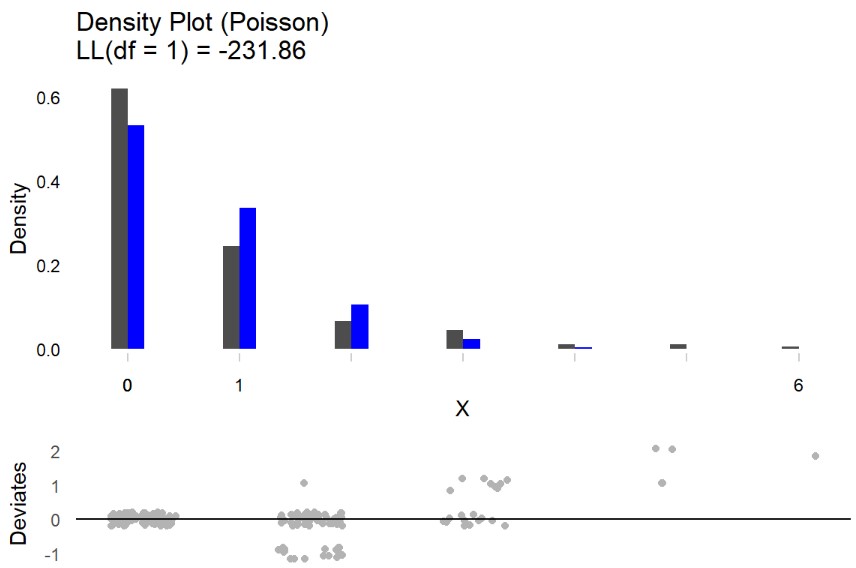W5 - Poisson regression
1/18
There's no tags or description
Looks like no tags are added yet.
Name | Mastery | Learn | Test | Matching | Spaced |
|---|
No study sessions yet.
19 Terms
Normal distribution parameters
mean
standard deviation
Poisson distribution parameters
one parameter: lambda (the mean and variance of the poisson distribution)
Outcome variable types - Poisson distribution
count outcome variables
discrete positive integers
as lambda increases the distribution …
begins to look more similar to a normal distribution
Why linear regression cannot be used for count data
The normality distribution would be violated (unless high avg counts)'
Can't have negative numbers
Certainty at extreme values is impossible when the outcome can only be 0 or positive whole numbers
when an outcome can only be 0 or positive whole numbers, a straight line is a bad fit, and is impossible for extreme values (negative)
Solution: link function
resolves the issue of count data not having negative values
the link function transforms the linear predicted value η so that it never goes below zero
Group comparisons
poisson and logistic regression used z-scores rather than t-values
Link function for poisson regression
η = g(λ) = ln(λ)
Takes the average number of counts (lambda), which can only fall > 0, and transforms it to fall between negative infinity and positive infinity. This gives us a continuous and unbounded outcome we can apply a linear model to.
natural log transformation unbounds lambda on the left side of the graph so that it never goes below zero
log of zero = negative infinity (cannot go under zero)
ln()
the natural logarithm (or log with base e, euler's number)
Poisson regression
Used when the outcome is a count variable (discrete, whole and positive)
Poisson distribution used when the counts are relatively rare
Poisson distribution: discrete, density curve not plotted
Only has one distribution parameter - Lambda (mean + variance)
As lambda increases may start to look more like a normal distribution
Inverse link function
reverts predictions made from linear model back to original count scale so predictions can be interpreted
transforms eta back to fall > 0
Poisson regression assumptions
assumes a poisson distribution
errors are independent
assumes that on the link scale (natural log scale) there is a linear relationship
assumptions of equal variance and normality not required
Requires a large sample size. There are no degrees of freedom so sample must be large enough that parameters are distributed about normally relying on the central limit theorem
*no agreed upon method for evaluating whether residual meet assumptions
Poisson regression in R
Use glm() function
When using anything other than a linear model need to specify family argument e.g. family = poisson()
m <- glm(num_awards ~ math, data = dcount, family = poisson())
Poisson output
Deviance residuals: how much each data point contributed to the residual deviance. Measure of overall model fit. Not calculated as the raw difference between each data point and predicted value.
Coefficients: z-values instead of t-values as we cannot calculate degrees of freedom
No R2 - only works for linear regression. Instead get the null and residual deviance values and an AIC (relative measure of model fit taking into account model complexity)
Number of Fisher scoring iterations
Poisson regression interpretation
A poisson regression predicting the number of awards each student received from their math scores showed that students who had a 0 math score were expected to have -5.33 log awards, p < .001. Each one unit higher math score was associated with 0.09 higher log awards, p < .001. A graph of these results follows.
- by specifying that we are working on a log scale can interpret the results as we did before
hard to interpret results on log scale
Incident rate ratios
Obtained by exponentiating the regression coefficients (slopes)
*can exp coefficients & confint, but not p-values or z-values
IRRs indicate how many more times the outcome will be for a one unit change in the predictor
e.g. if the IRR=2 and the base rate was 1, then one unit higher would be 1∗2=2. If the base rate was 2, then a one unit higher would be 2∗2=4
IRRs are interpreted as for each one unit higher predictor score, there are IRR times as many events of the outcome.
How much your outcome is expected to increase in count numbers
As IRRs are multiplicative, an IRR of 1 means that a one unit change in the predictor is associated with 1 times as many events on the outcome, that is no change.
On the IRR scale, a coefficient of 1 is equivalent to a coefficient of 0 on the link (log) scale
Interpretation using IRRs
A poisson regression predicting the number of awards each student received from their math scores showed that students who had a 0 math score were expected to have 0.00 awards, [95% CI 0.00 - 0.01]. Each one unit higher math score was associated with having 1.09 times the number of awards, [95% CI 1.07 - 1.11], p < .001. A graph of these results follows.
eta
expected part of the model without error term
Poisson testDistribution()
discrete distribution
solid grey bars show the observed density of different values
blue bars show the density under a poisson distribution
deviates plot show the deviations from the assumed poisson distribution
